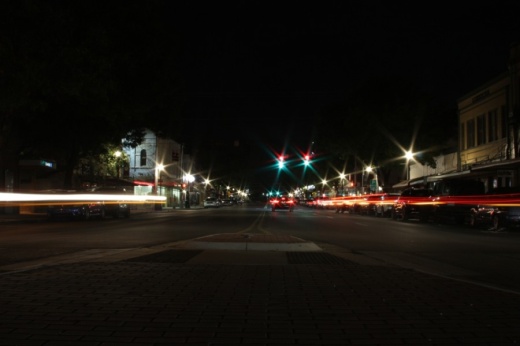She has watched the area where she conducts business explode with activity and new development over the last several years. Because of this, it is her view that much work is needed to update, revitalize and make more accessible the city’s downtown area.
“I grew up here, and in the last eight years downtown has certainly come alive,” Balmos said. “What we’ve begun to do here is to have a viable variety of things for people to walk in and out of that are interesting.”
With coronavirus restrictions easing and businesses in the heart of downtown New Braunfels expanding their hours and services, improvement efforts have resumed full force, and area officials and business owners have resumed efforts to improve the city center.
In 2010, the city of New Braunfels’ Downtown Implementation Plan was approved. It was created to provide developers and officials with guidelines for future developments and revitalization efforts in downtown New Braunfels.
The city then finalized its comprehensive plan, titled Envision New Braunfels, in 2018 that identified key areas of growth and outlined goals for the city’s future through 2030.
Both documents cited the need for increased parking availability, improved sidewalks, wayfinding signage and carefully planned developments in the downtown area as key elements to ensure the district continues to grow.
Though the city has installed more public parking and is currently piloting wayfinding signage, downtown business owners believe more is needed to attract new visitors and businesses to the area.
Because of this identified need, city leaders, business owners and other stakeholders have been working to invigorate a three-pronged revitalization effort in the downtown area centered on improved infrastructure, vibrant marketing and more accessible parking.
“I think parking is a topic that is always at the forefront when you talk about downtown,” Balmos said. “When we talk about fixing an obstacle I definitely believe we need more parking.”
The challenge of getting around
In 2016, the city hired Walker Parking Consultants to study parking options available in the downtown area. The study found that much of the city’s parking is underutilized due to lack of signage or because it is privately owned.
“We have this sort of abundance of parking that is not publicly available,” said Amy McWhorter, economic and community development coordinator for the city of New Braunfels. “We've been able to add some more parking, which has kind of alleviated some of our need to lease parking, but we definitely want to keep an eye on where new developments are coming in and what kind of demand they're inducing for parking.”
The city added 57 free parking spots to the county-owned Bridge Street Parking Lot in 2019, bringing the total to approximately 940 free on and off-street parking spots, compared to more than 2,720 private parking spots.
In 2020, the city ended its lease on a parking lot located on South Castell Avenue that served several restaurants and the weekly farmer’s market. The lot is privately owned and is now only available for paid public parking from 5 p.m.-2 a.m. Monday through Friday and 6 a.m.-2 a.m. Saturday through Sunday.
Chad Niland, owner of The Downtowner, said the conversion of the lot from public to private has made it difficult for customers to find a place to park.
“I don't mind it's paid parking,” Niland said. “It’s really expensive for two hours or four hours, and that's not enough time. When people come downtown, they want to go everywhere. You know they're going to be out for a lot longer than four hours.”
McWhorter said more property owners and businesses have begun to consider paid parking models, a move that demonstrates the value of parking spaces in the quickly growing city.
The Brauntex Theatre, which owns a small parking lot that was donated to the nonprofit, recently opened the spaces up for public parking for five dollars, according to Delia Milam, capital campaign coordinator for the theater.
Milam said while both free and paid parking options are available, visitors have expressed frustration with trying to find a spot or with having to walk a significant distance from their parking spot to their destination.
After evaluating the parking situation downtown, the city has decided not to pursue a public parking garage or similar structure, though the topic may be revisited in the future.
“Before you leave your house, you do consider what time of day it is, what day it is and whether or not you really want to battle the possibility of having to drive around to find something,” Balmos said. “In that sense, it is an obstacle because there isn't this kind of free-thinking of ‘oh I'll just pop down to downtown.’”
Improving the infrastructure
In addition to addressing concerns about parking, the city and Downtown Association have been collaborating to install signage that will help visitors navigate the district. Pilot signage has been installed at the intersection of Castelle Avenue and West San Antonio street, and a wayfinding kiosk was set up in the Bridge Street parking lot.
City officials have also introduced the concept of adding curb extensions to key intersections throughout downtown to make pedestrian-dense roadways safer, though McWhorter said the installation of the feature could take up to a year.
Pedestrian crossings surrounding the Main Plaza are the key areas being considered for the extensions due to the challenges associated with crossing the two-lane traffic circle, which is a primary feature of the area’s infrastructure, McWhorter said.
According to a recent city-sponsored traffic survey, 95% percent of motorists who drive on it only utilize the outside lane, and reducing the roadway to one lane could make it safer for drivers and pedestrians.
Though many stakeholders have supported the reconfiguration, the circle is owned by the Texas Department of Transportation, and the city has no authority to change the roadway. Because of this, it is difficult to predict if and when the change may be made.
“Taking the circle down to one lane would be beneficial for pedestrians... having just a single lane of traffic really simplifies it for them,” McWhorter said. “The overarching theme of downtown is pedestrian friendliness.”
New development coming
Infrastructure will also factor into future planning from the perspective of incoming development.
Though The Downtowner is one of the farthest south businesses on South Castell Avenue, it will eventually be joined by a mixed-use development at the intersection of S. Castell Ave. and W. Garden Street.
The South Castell Avenue project will join the civic center and is expected to incorporate multifamily housing, a hotel, retail and office space.
“In preparation for that development coming in, we've recently had an engineering firm come in and study the right of way on Castell Avenue,” McWhorter said. “We've been in negotiations with [Union Pacific] railroad, because there's that active rail yard over there which is a little bit of a detriment to new development.”
Once the right of way study is complete and an agreement has been reached with Union Pacific, McWhorter said work will begin in earnest to finalize designs and attract developers.
The project will join the ongoing construction of a retail and office project on East San Antonio Street as well as the upcoming conversion of the New Braunfels Utilities property into a mixed-use development.
A focus of the NBU project will be to maintain the historical significance of the building while introducing diverse businesses, according to Pat Butler, a member of the city’s Downtown Board and the advisory committee for the NBU property.
Three entities were invited to submit proposals for the project in April, Butler said.
“By doing things like the South Castell Avenue project, that means adding residency ... adding more use of the Civic Convention Center,” said Michael Meek, former chamber president and current chamber consultant. “All those things will create ... that circular flow that successful, vibrant areas have.”
Marketing downtown to visitors
One of the key ways downtown is advertised to visitors and residents is through annual events and activities hosted by the city, the DTA and the chamber of commerce.
During the coronavirus pandemic, many of the area’s high-profile annual and regular activities including Wein and Saengerfest, First Fridays and Wassailfest that boosted activity in downtown were canceled.
In March, First Fridays was one of the first events to return to downtown, said DTA president Heidi Aleman. As part of that event, businesses that participate in the monthly event keep their stores open later and offer special discounts and deals.
“I do believe that people do like to just simply walk around, and I don't know if there's enough to do other than from restaurant to restaurant to bar to bar, or to the few retailers that are open later,” Balmos said. “No one generally is in a hurry, once you're out and about on a weekend, to rush back home.”
Balmos said when business owners such as herself choose to stay open later, there is a risk due to the possibility of added payroll costs, but as more people return to in-person dining and shopping, it is a strategy that can make the city center feel more engaging.
Marketing efforts and regular events initiated by the DTA, chamber and city have been designed to promote downtown and help visitors better understand all it has to offer, Butler said.
“I wish we did a little more marketing to let people know how vibrant downtown is, and really highlight different stores,” Niland said. “You know, there's more than just a river.”





